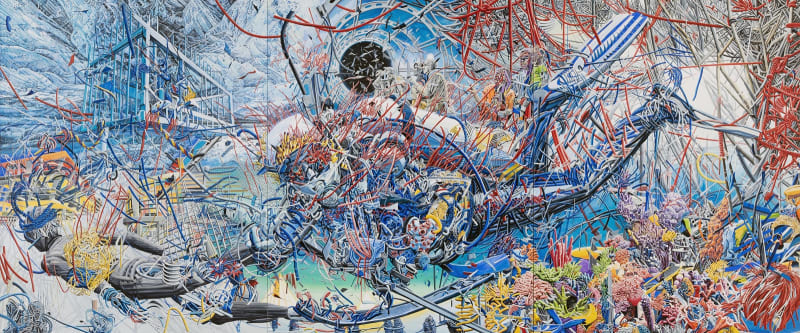Rhapsody of Collected Desires
Ko Yeonsoo (art critic)
We constantly try to suppress, restrain, and, if possible, control our desires. When that proves difficult, we seek reconciliation, soothing them however we can-our goal being to avoid provoking or stimulating them too much. Desire has always been wrapped in the premise that it stems from deficiency and lack, making true satisfaction nearly impossible. It has been concealed, deemed taboo, and dismissed as a mere instinctual trait of human nature.
Sigmund Freud defined desire as the longing for what one does not possess-an "image," a "fantasy," a "representation." In contrast, Gilles Deleuze rejected the notion of a desiring subject altogether, arguing that all life flows creatively, propelled by the currents of desire that generate difference and motion. Just as plants reach toward the sun, insects toward plants, and humans toward animals and vegetation, Deleuze claimed that desire does not originate from an absence of the subject in the objective world. Instead, he saw it as an immanent force of life itself.
For Deleuze, desire is a natural, productive flow, akin to a machine that continuously generates and connects. It exists solely to sustain and reproduce itself, forming connections in an ongoing process of becoming.
"I create works by setting and constructing a specific world, much like an aquarium designed to accommodate the wet life of plants and animals. The aquarium, filled with blue light, seemed like an apt symbol to represent the infinite space of human desire. (…) My goal is to reflect the present era, where we simultaneously live in the tangible reality and a logically structured virtual environment. Although it is a rationally built structure, I aim to capture the contradictions inherent in the virtual world through my paintings. (…) I seek to express the blurring and entangling of boundaries between places I have experienced and spaces I have not."
- From the artist's notes -
- From the artist's notes -
Edited Desires from an Appropriate Distance
Artist Kim Hyo-sook composes her paintings by accumulating and layering images collected from her movements through various spaces and events. Her works from 2008 to 2010 depict the fragmented structures of an incomplete city, resembling pixelated clusters. These assembled forms create an impression of rapidly evolving urban landscapes, appearing to be in the process of completion-yet, just as quickly, they are abandoned and left in decay. The fragmented spaces and scattered remnants are densely narrated within her canvases.
Past and present experiences, visual memories, and the relentless influx of images and events all converge in her work. This results in a transcendental composition that dismantles conventional perceptions of space and time, driven by a mechanized impulse to capture and reconstruct.
Since 2011, her cityscapes have transformed into more organically dense units. Post-2015, her Blue Room (Travelers and Virtual Aquarium) series presents surreal, fantastical environments, shifting the viewer's gaze. Whether depicting a drifting cityscape or a virtual aquarium's blue-lit chamber, Kim's perspective remains consistent. She presents a tangled mass of visible realities, hidden or imagined elements, and desires carefully concealed for better visibility.
This process of editing desire is not simply an artificial act of connection or forced fusion. Instead, it manifests as an intricate marbling of juxtaposed elements, seamlessly blended. Her paintings do not dwell on wounds, deficiencies, or unattainable desires directed toward an absent subject. Rather, they reveal a visual artist's meticulously refined and mediated impulse-a desire stemming from the embodied experience of perception and visual reconstruction.
A Virtual Space Where Collected Desires Float Freely
In Hayao Miyazaki's animated film Laputa: Castle in the Sky, the floating castle represents different things to different people. For some, it is a deeply cherished dream; for others, it is a treasure trove of hidden wealth; and to some, it is a strategic conquest for absolute power. Despite its uncertain existence, those who believed in it projected their desires onto it-an island of aspirations. Ultimately, the castle belonged to the dreamers.
The recurring motif in Kim Hyo-sook's work is floating. The structures she constructs do not rest on solid ground; they drift without settling in any single place, emphasizing their detachment from reality. These surreal configurations are composed of floating fragments, each occupying a distinct frame and shape. The massive forms suggest an unreal quality, yet their constituting elements-pixelated blocks, fine interwoven lines, and cellular units-are deeply rooted in reality.
Just as the floating island of Laputa is sustained by the roots of a great tree, the interconnected elements in Kim's work remain grounded in reality. Her earlier works featured dense accumulations of fragments, where hidden human figures subtly linked the chaotic compositions to tangible life. The tangled structures in her paintings are meticulously controlled, reconstructed, and recontextualized into virtual spaces, yet her recent works show a shift. Now, her compositions reveal organic linkages akin to blood vessels, visually binding the real and the imagined.
Kim Hyo-sook's artistic desire to collect visual fragments and synthesize them into a singular frame will likely continue evolving. However, her desire does not lie merely in the densely packed, fragmented imagery of reality. As long as her internalized creative space remains open-continuously cycling between emptiness and fullness-her work will keep flowing, assembling and dispersing in new forms.


